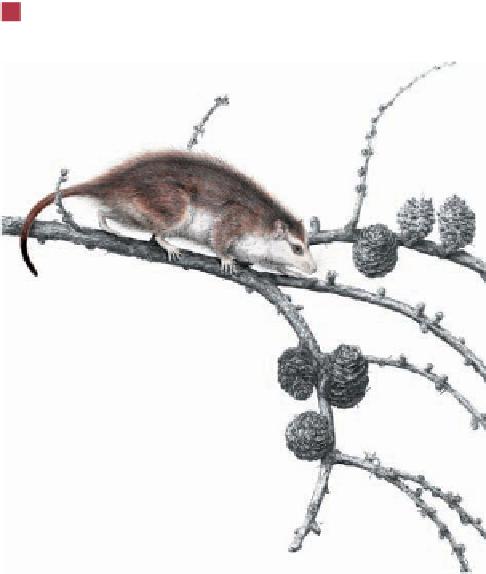Geology Reference
In-Depth Information
continent until late in the Cenozoic and its fauna, evolving
in isolation, became increasingly different from faunas else-
where. Marsupial mammals reached Australia from South
America via Antarctica, but the South American connection
was eventually severed. Placentals, other than bats and a few
rodents, never reached Australia, thus explaining why marsu-
pials continue to dominate the continent's fauna even today.
Cretaceous climates were more strongly zoned by lati-
tude, but they remained warm and equable until the close of
that period. Climates then became more seasonal and cooler,
a trend that persisted into the Cenozoic. Dinosaur and mam-
mal fossils demonstrate that interchange was still possible,
especially between the components of Laurasia.
◗
Figure 22.32
Mesozoic Mammals
IN THE HISTORY OF LIFE
The greatest mass extinction took place at the end of the
Paleozoic Era, but the one at the close of the Mesozoic
has attracted more attention because among its casualties
were dinosaurs, fl ying reptiles, and marine reptiles. Several
kinds of marine invertebrates also went extinct, including
ammonites, which had been so abundant during the Meso-
zoic, rudistid bivalves, and some planktonic organisms.
Hypotheses to explain Mesozoic extinctions are numerous,
but most have been dismissed as improbable, untestable, or in-
consistent with the available data. A proposal that has become
popular since 1980 is based on a discovery at the Cretaceous-
Paleogene boundary in Italy—a 2.5-cm-thick clay layer with
a remarkably high concentration of the platinum-group ele-
ment iridium (
a
Restoration of the oldest known marsupial mammal,
Sinodelphys
, which measures 15 cm long.
Figure 22.33a). High iridium concentrations
have now been identifi ed at many other Cretaceous-Paleogene
boundary sites.
The signifi cance of this
iridium anomaly
is that iridium
is rare in crustal rocks, but is found in much higher concen-
trations in some meteorites. Accordingly, some investigators
propose a meteorite impact to explain the anomaly and fur-
ther postulate that the impact of a meteorite, perhaps 10 km
in diameter, set in motion a chain of events leading to ex-
tinctions. Some Cretaceous-Paleogene boundary sites also
contain soot and shock-metamorphosed quartz grains, both
of which are cited as additional evidence of an impact.
According to the impact hypothesis, approximately 60
times the mass of the meteorite was blasted from the crust
high into the atmosphere, and the heat generated at impact
started raging forest fi res that added more particulate matter
to the atmosphere. Sunlight was blocked for several months,
temporarily halting photosynthesis; food chains collapsed;
and extinctions followed. Furthermore, with sunlight greatly
diminished, Earth's surface temperatures were drastically re-
duced, adding to the biologic stress. Another consequence of
the impact was that vaporized rock and atmospheric gases
produced sulfuric acid (H
2
SO
4
) and nitric acid (HNO
3
).
Both would have contributed to strongly acid rain that
may have had devastating effects on vegetation and marine
organisms.
◗
b
This restoration shows
Eomaia
, the oldest known placental
mammal. It was only 12 or 13 cm long. Both fossils come from
Early Cretaceous-age rocks in China.



Search WWH ::

Custom Search